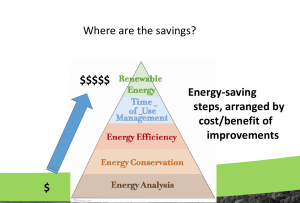Energy Efficiency in Agriculture
The agricultural industry consumes massive amounts of energy. In 2015 alone, farmers paid 10 billion dollars collectively in energy bills. Agricultural facilities expend energy in refrigeration and materials handling, pumping and heating, lighting, and fans.
In mid-June, VAEEC hosted a webinar with presenters Josh Ludgate from Energy Exact Inc. and Erin Puryear from Old Dominion Electric Cooperative. In 2012, Old Dominion Electric Cooperative and its nine Virginia distribution electric cooperatives, collaborated with the state energy office, Exact Energy, James Madison University, US Dept of Agriculture Natural Resources Conservation Service, USDA-Rural Development, and Virginia Dept of Agriculture and Consumer Services to develop a plan for offering information, education, and opportunities in energy efficiency for the agricultural sector. During the webinar, Josh and Erin share what this plan has entailed, the challenges and successes, and how they plan to move forward.
 Erin introduced the Energy-saving steps, arranged by cost/benefit improvement pyramid. The base of the pyramid is Energy Analysis:
Erin introduced the Energy-saving steps, arranged by cost/benefit improvement pyramid. The base of the pyramid is Energy Analysis:
- Energy analysis must be made to identify costs and find opportunities where energy use can be reduced. Erin explained that after the energy analysis is made, agricultural facilities can achieve their cost/benefits achievement goals through the following:
- Energy conservation is the most cost beneficial approach an agricultural facility can take. It involves finding behavioral changes that can be implemented to increase energy saving.
- Energy efficient equipment is the next most cost beneficial approach an agricultural facility can take and includes fans, pumps or lights.
- Time of use management is the third most cost effective approach and includes using energy at an off peak hour to save money and electricity.
- Lastly, using Renewable energy, such as solar power, wind power, hydropower, biofuels, is helpful but it is the least cost beneficial.
Erin also discussed funding options, such as grants and loans through the USDA and education and awareness initiatives held in rural Virginia.
After Erin’s presentation, Josh with Exact Energy, reviewed a case study for poultry breeders and growers. Many growers had expressed skepticism to try energy savings technologies because of the perceived risk of high bird mortality. Growers were concerned the new bulbs would confuse the birds and affect yields. Typically, growers use either 100 W incandescent or CFL bulbs or 150 W High Pressure Sodium lamps. In this case study, energy monitoring systems and 23 W compact fluorescent bulbs and LED bulbs were installed in three houses to test several flocks. The lighting electrical consumption dropped by 80% and the average savings of the three houses was $522.99. Growers were overly pleased with the equipment installed, and the case study found that though there is room for advancements, there were no increases or decreases in bird production after implementing the recommendations.
In a state with over 6,000 poultry farms, there is a huge potential to access cost and energy savings for the agricultural sector.
For more information, view the entire presentation or listen to the audio recording.
